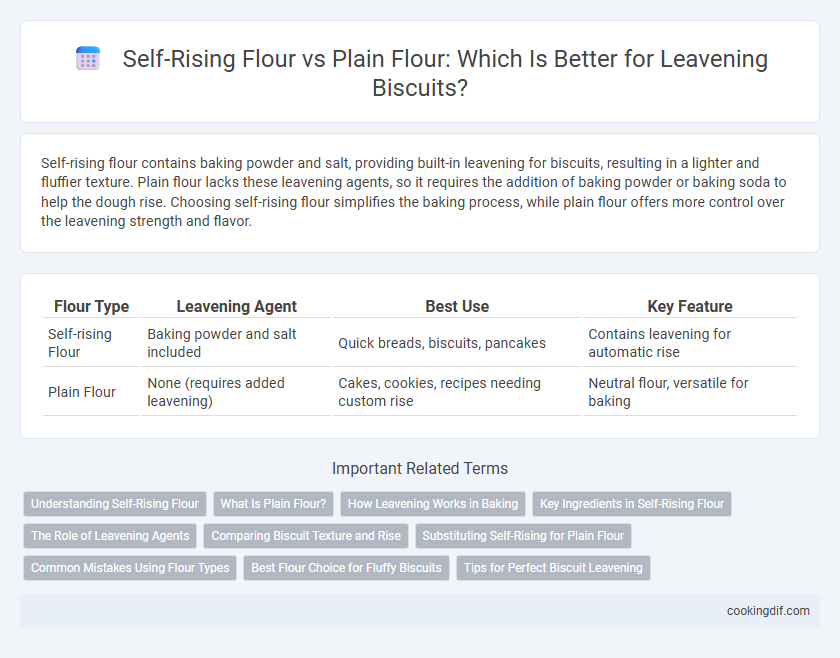Self-rising flour contains baking powder and salt, providing built-in leavening for biscuits, resulting in a lighter and fluffier texture. Plain flour lacks these leavening agents, so it requires the addition of baking powder or baking soda to help the dough rise. Choosing self-rising flour simplifies the baking process, while plain flour offers more control over the leavening strength and flavor.
Table of Comparison
| Flour Type | Leavening Agent | Best Use | Key Feature |
|---|---|---|---|
| Self-rising Flour | Baking powder and salt included | Quick breads, biscuits, pancakes | Contains leavening for automatic rise |
| Plain Flour | None (requires added leavening) | Cakes, cookies, recipes needing custom rise | Neutral flour, versatile for baking |
Understanding Self-Rising Flour
Self-rising flour contains a precise blend of all-purpose flour, baking powder, and salt designed to provide consistent leavening in biscuits without the need for additional raising agents. This pre-mixed combination allows dough to rise effectively during baking, producing tender, fluffy biscuits with a light texture. Using plain flour requires adding baking powder and salt separately, making self-rising flour a convenient choice for reliable, evenly-leavened biscuit results.
What Is Plain Flour?
Plain flour, also known as all-purpose flour, is a versatile wheat flour that contains no added leavening agents, making it ideal for recipes requiring additional control over rising. Unlike self-rising flour, which includes baking powder and salt, plain flour allows bakers to customize leavening by adding baking soda, baking powder, or yeast according to the specific biscuit recipe. Its neutral composition provides a consistent texture and flavor foundation essential for achieving the perfect biscuit crumb.
How Leavening Works in Baking
Self-rising flour contains a pre-mixed combination of baking powder and salt, which releases carbon dioxide gas during the baking process to naturally leaven biscuits. Plain flour, also known as all-purpose flour, requires the addition of an external leavening agent like baking powder or baking soda to generate bubbles that create rise and lightness. The leavening occurs as these agents react with moisture and heat, producing gas that expands the dough's structure, resulting in soft and fluffy biscuits.
Key Ingredients in Self-Rising Flour
Self-rising flour contains a precise blend of all-purpose flour, baking powder, and salt, which acts as a leavening agent, eliminating the need for additional baking powder in biscuit recipes. Plain flour lacks these leavening agents, requiring separate ingredients to achieve the desired rise and fluffiness. The pre-mixed chemical leaveners in self-rising flour provide consistent and reliable rising, making it a convenient choice for quick and light biscuits.
The Role of Leavening Agents
Self-rising flour contains pre-mixed leavening agents such as baking powder and salt, which facilitate the dough's rise by releasing carbon dioxide during baking. Plain flour, on the other hand, lacks these leavening agents and requires added baking powder or baking soda for proper biscuit leavening. The presence or absence of leavening agents directly impacts the texture, density, and rise of biscuits.
Comparing Biscuit Texture and Rise
Self-rising flour contains baking powder and salt, which naturally enhance biscuit rise and create a lighter, fluffier texture compared to plain flour. Plain flour requires additional leavening agents like baking powder or baking soda to achieve a similar rise and tender crumb. Using self-rising flour simplifies the process and consistently produces soft, airy biscuits with a more delicate crumb structure.
Substituting Self-Rising for Plain Flour
Substituting self-rising flour for plain flour in biscuit recipes alters leavening due to the inclusion of baking powder and salt in self-rising flour, which accelerates dough rise. When using self-rising flour, reduce or eliminate added leavening agents like baking soda or baking powder to prevent over-rising and achieve the ideal biscuit texture. Understanding the differences improves recipe accuracy and ensures biscuits maintain their intended lightness and crumb structure.
Common Mistakes Using Flour Types
Using plain flour instead of self-rising flour in biscuit recipes often leads to flat and dense biscuits due to the lack of added leavening agents like baking powder and salt. A common mistake is neglecting to adjust the amount of baking powder when substituting plain flour, which can result in insufficient rise and poor texture. Understanding the leavening properties of self-rising flour ensures proper biscuit lift and a tender crumb.
Best Flour Choice for Fluffy Biscuits
Self-rising flour contains baking powder and salt, making it ideal for achieving fluffy biscuits with a reliable rise and light texture. Plain flour lacks leavening agents, requiring the addition of baking powder or baking soda to produce similar results. For consistently soft and airy biscuits, self-rising flour is the best choice, simplifying the baking process and ensuring perfect leavening every time.
Tips for Perfect Biscuit Leavening
Use self-rising flour for biscuits to achieve consistent leavening, as it contains the ideal balance of baking powder and salt that helps the dough rise evenly. When using plain flour, add the correct amount of baking powder--typically 1 to 1.5 teaspoons per cup--to ensure proper lift without over-leavening. Always sift the flour and baking powder together to distribute leavening agents uniformly, which promotes light, fluffy biscuit texture.
Self-rising flour vs plain flour for leavening Infographic

 cookingdif.com
cookingdif.com